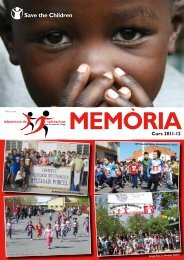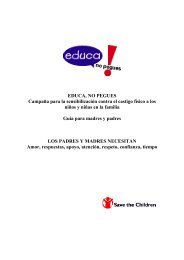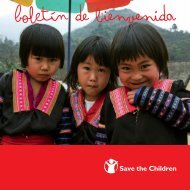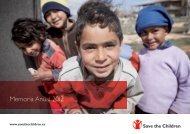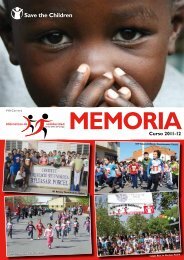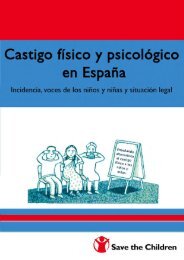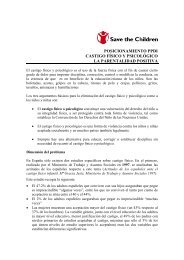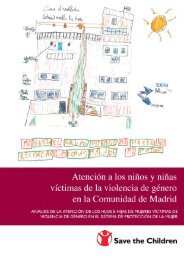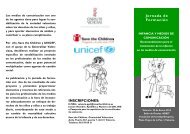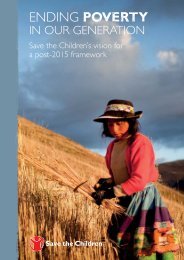Nutrition in the First 1,000 Days - Save the Children
Nutrition in the First 1,000 Days - Save the Children
Nutrition in the First 1,000 Days - Save the Children
You also want an ePaper? Increase the reach of your titles
YUMPU automatically turns print PDFs into web optimized ePapers that Google loves.
34 SaviNg liveS aND BUilDiNg a Better FUtUre: loW-coSt SolUtioNS that WorK<br />
more than 3,400 temporary sites were organized to deliver vitam<strong>in</strong> A with<strong>in</strong><br />
small, isolated communities. Frontl<strong>in</strong>e health and nutrition workers and<br />
community volunteers <strong>in</strong> <strong>the</strong> 38 districts of Bihar were tra<strong>in</strong>ed to adm<strong>in</strong>ister<br />
preventive vitam<strong>in</strong> A syrup to children and to counsel mo<strong>the</strong>rs on how<br />
to improve <strong>the</strong> vitam<strong>in</strong> A content of <strong>the</strong>ir children’s diet. In 2009, Bihar’s<br />
vitam<strong>in</strong> A supplementation program reached 13.4 million children under 5,<br />
protect<strong>in</strong>g 95 percent of children <strong>in</strong> this age group aga<strong>in</strong>st <strong>the</strong> devastat<strong>in</strong>g<br />
consequences of vitam<strong>in</strong> A deficiency.111 In 2010, national coverage for India<br />
as a whole was estimated at only 34 percent.112<br />
• Vietnam has a strong public health system at all levels that <strong>in</strong>cludes over<br />
100,<strong>000</strong> community health workers113 and a specific cadre called “nutrition<br />
collaborators” who staff cl<strong>in</strong>ics and do home visits. These health workers<br />
screen children for malnutrition, treat diarrhea and counsel mo<strong>the</strong>rs about<br />
breastfeed<strong>in</strong>g, balanced diet, hygiene and sanitation. With <strong>the</strong> help of <strong>the</strong>se<br />
health workers, Vietnam is mak<strong>in</strong>g promis<strong>in</strong>g progress toward <strong>the</strong> MDGs.<br />
By 2015 <strong>the</strong> country is almost certa<strong>in</strong> to reach MDGs 4 and 5 related to<br />
child and maternal mortality. S<strong>in</strong>ce 1990, Vietnam has cut child mortality<br />
by 55 percent114 and maternal mortality by 66 percent.115 Over <strong>the</strong> past<br />
two decades Vietnam has also cut child stunt<strong>in</strong>g by over 60 percent (from<br />
61 percent <strong>in</strong> 1989 to 23 percent <strong>in</strong> 2010)116 and s<strong>in</strong>ce 2005, <strong>the</strong> country has<br />
nearly elim<strong>in</strong>ated iod<strong>in</strong>e deficiency <strong>in</strong> pregnant women and children.117<br />
• In Mali, community health workers <strong>in</strong> one program helped ensure more<br />
than 90 percent of mo<strong>the</strong>rs took daily doses of iron-folic acid and multiple<br />
micronutrients.118 In nationwide efforts from 2002-2007, Mali’s government<br />
tra<strong>in</strong>ed 22,<strong>000</strong> community health workers on several nutrition-related<br />
<strong>in</strong>terventions to improve child survival. Each health worker was responsible<br />
for 35 households and was expected to visit each household monthly. The<br />
health workers delivered vitam<strong>in</strong> A to women and children under 5. They<br />
also discussed <strong>the</strong> benefits of exclusive breastfeed<strong>in</strong>g <strong>in</strong> <strong>the</strong> first 6 months of<br />
life and <strong>the</strong> risks of giv<strong>in</strong>g water <strong>in</strong>stead of breast milk.119 Program-specific<br />
results are not available, but national-level surveys have reported early <strong>in</strong>itiation<br />
of breastfeed<strong>in</strong>g <strong>in</strong>creased from 10 percent <strong>in</strong> 1995/96, to 43 percent <strong>in</strong><br />
2007. Exclusive breastfeed<strong>in</strong>g rose from 8 to 34 percent.120<br />
• In Mongolia, community health volunteers deliver multiple micronutrient<br />
powders – known as “Spr<strong>in</strong>kles” – that can improve vitam<strong>in</strong> and m<strong>in</strong>eral<br />
<strong>in</strong>take among children over 6 months old. The powders conta<strong>in</strong> up to 15<br />
vitam<strong>in</strong>s and m<strong>in</strong>erals (such as iron, and vitam<strong>in</strong>s A and D), are relatively<br />
tasteless, odorless, colorless, and are safe and easy to use. They cost about 3<br />
cents per sachet (one child typically gets 60 to 90 sachets per year). Mongolia<br />
is <strong>in</strong>troduc<strong>in</strong>g Spr<strong>in</strong>kles as part of an <strong>in</strong>tegrated approach to improve young<br />
child feed<strong>in</strong>g and reduce anemia and stunt<strong>in</strong>g. In 2001, when <strong>the</strong> country<br />
began distribut<strong>in</strong>g Spr<strong>in</strong>kles as part of a pilot program, around 42 percent of<br />
preschool-age children were anemic. Public health workers and community<br />
volunteers gave 30 sachets monthly to children. One year <strong>in</strong>to <strong>the</strong> program,<br />
13,<strong>000</strong> children, or more than 80 percent of those targeted, had received<br />
multi-micronutrient powders, and anemia was reduced to half of basel<strong>in</strong>e<br />
levels.121 Mongolia is currently scal<strong>in</strong>g-up <strong>the</strong> program nationally, aim<strong>in</strong>g<br />
to reach 49,480 children under age 2. Nurses, public health workers and<br />
community volunteers are distribut<strong>in</strong>g sachets at health posts.122<br />
vietnam




